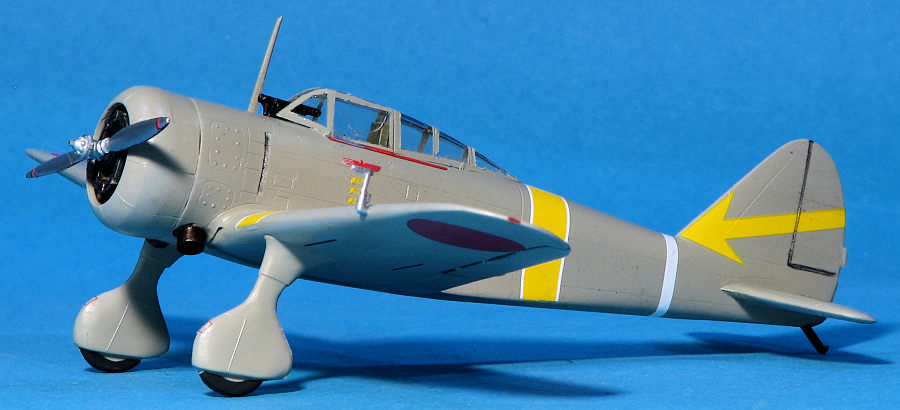
Hasegawa 1/72 Ki-27 'Nate'
| KIT #: | JS-133 |
| PRICE: |
300 yen when new (about $1.25 at the time) Recently purchased for $5 on the used kit market |
| DECALS: | Two options |
| REVIEWER: | Scott Van Aken |
| NOTES: |

| HISTORY |
The Ki-27 was the army's main fighter until the start of World War II. In the 1939 Battle of Kalhin Gol against USSR in Mongolia, Ki-27 faced I-15 biplanes and I-16 monoplanes, and dominated them with its maneuverability, downing a total of 1,252 enemy aircraft. The Ki-27's high turn performance caused the Army to focus almost exclusively on maneuverability, a decision which came back to haunt them later as it handicapped the development of more heavily armed and faster fighters. The Ki-27 served until the beginning of World War II in the Pacific, escorting bombers attacking Singapore. After it was replaced by the Ki-43, Ki-27 continuing to serve as a trainer, was used in 'back water' areas and for home defense. It was also exported for use with Manchukuo and Thai armed forces, seeing combat with both. In Thai service, the Ki-27 reportedly damaged a P-51 Mustang and shot down one P-38 Lightning. Near the end of World War II, a few Ki-27 were equipped with up to 500 kg (1,100 lb) of explosives for Kamikaze duty.
In spite of its excellent turning performance, in
combat Ki-27 suffered from lack of ar mor protection for the pilot and absence of
self-sealing or fire suppression in the fuel tanks. In addition, the airframe
could not handle the stress of high speeds and Soviet pilots routinely escaped
Ki-27 attacks in a dive. The armament of two rifle-caliber machine guns was
weak. Many of these planes were shot down by the P-40s of the AVG. The main
difference between the Ki-27a and Ki-27b was the latter's addition of bomb racks
and the provision for under wing fuel tanks.
mor protection for the pilot and absence of
self-sealing or fire suppression in the fuel tanks. In addition, the airframe
could not handle the stress of high speeds and Soviet pilots routinely escaped
Ki-27 attacks in a dive. The armament of two rifle-caliber machine guns was
weak. Many of these planes were shot down by the P-40s of the AVG. The main
difference between the Ki-27a and Ki-27b was the latter's addition of bomb racks
and the provision for under wing fuel tanks.
Tateo Katō was born and raised in present-day Asahikawa, Hokkaidō. His father Sergeant Tetsuzo Katō was killed in the Russo-Japanese War. He graduated from the 37th class of the Imperial Japanese Army Academy in 1925, and enrolled in the Tokorozawa Flying School two years later.
In May 1927, he was posted to the 6th Hiko Rentai (flight regiment) in Pyongyang, Korea. His flying skill with the Kawasaki Ko-4 biplane fighter (a license-built Nieuport-Delage NiD 29) was so outstanding that he was selected to become a flight instructor at Tokorozawa in 1928. In 1932, Katō was promoted to head instructor at the Akeno Flying School, the premier air academy for the Imperial Japanese Army Air Force. In 1936, Kato became commander of the 5th Rentai, and with the outbreak of the Second Sino-Japanese War in 1937, he became commander of the 2nd Daitai, equipped with Kawasaki Ki-10 "Perry" biplane fighters, which quickly achieved air superiority over northern China. Katō claimed nine Chinese fighters during his rotation, making him the top-scoring Army pilot in China during the period 1937-1941.
Katō returned to Japan in 1939 to attend the Army Staff College and was
assigned to the headquarters staff of the Imperial Japanese Army General Staff.
He also visited Europe on assignment, together with General Hisaichi Terauchi,
and inspected the Luftwaffe in Germany. During this period, he was also promote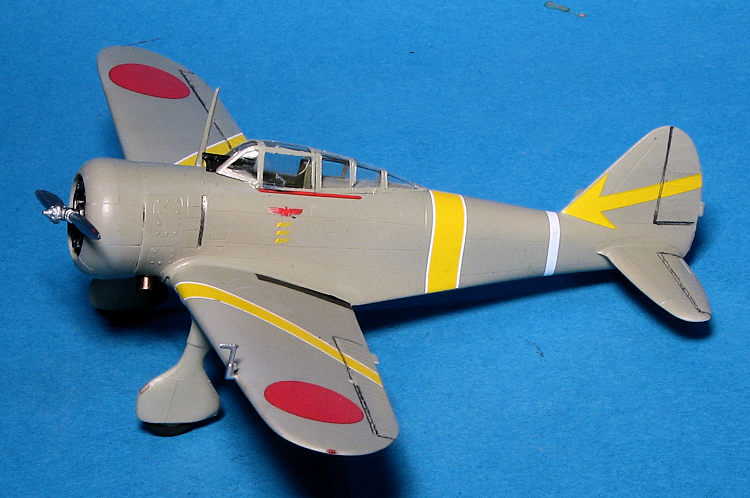 d
to major.
d
to major.
In 1941, with the start of the Pacific War, Katō was again given a combat command – this time as commander of the 64th Sentai, based at Guangzhou, China, and though initially equipped with the Ki-27 was later equipped with the latest Nakajima Ki-43 Hayabusa fighters. His unit participated in the early stages of the war, especially distinguishing itself during the Battle of Malaya. The 64th Sentai was based at Duong Dong airfield on Phu Quoc Island to provide cover for the Japanese invasion fleet bound for Malaya, and to attack ground targets in Malaya and Burma. The 64th Sentai had its first combat experience against the Flying Tigers on 25 December 1941, escorting a bomber raid on Rangoon. Under Katō's command, the unit recorded over 260 aerial victories over Allied aircraft. He disallowed individual victory credits for the sake of teamwork. Katō was promoted to Lieutenant Colonel in February 1942.
On May 22, 1942, while over the Bay of Bengal, Katō was killed in action while attacking a flight of No. 60 Squadron RAF Bristol Blenheim bombers. As Kato pulled up after making his first diving pass on the Blenheims, turret gunner Flight Sergeant "Jock" McLuckie raked the fighter's exposed belly with a long burst and the Ki-43 started to burn and crashed into the sea. Katō was posthumously promoted two steps in rank to major general, and was honored by a special State Shinto ceremony at Tokyo's Yasukuni Shrine as a "god of war" in mid-October 1942.
Katō's heroism had considerable propaganda value, and the Japanese government sponsored a movie titled Kato hayabusa sento-tai (加藤隼戦闘隊) (1944) glorifying his life story.
| THE KIT |
Hasegawa's offering of the Ki-27 in this scale is not a new kit by any means. It is from their raised panel line days and research shows that it was first issued in 1970. This is the 1977 boxing. Still, the condition of the sprues is excellent, with only a small amount of flash
The cockpit is rather basic with a floor, control
stick and seat back shape. There is no decal for the instrument panel. The
cockpit is supposed to be filled with pilot so any detailing will have to come
from somewhere else. A single piece engine/oil cooler assembly is provided and
it fits into a single-piece cow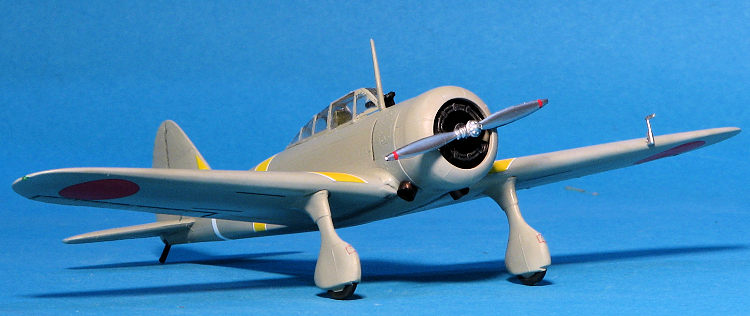 ling. Interestingly, the Hucks starter lug is a
separate piece and fits on the prop.
ling. Interestingly, the Hucks starter lug is a
separate piece and fits on the prop.
A one piece lower wing and two upper halves are the norm for this and it fits under the completed fuselage. Now for the options. You can have standard landing gear, the lower fairing removed, or later gear with balloon tires. Fuel tanks are provided and if you don't want to use them, you have to fill the placement holes. One also has an early or later rear canopy. The earlier one has much of the aft section closed off. Interestingly, one is shorter than the other, though the markings placement diagram shows them the same length. There is a telescopic gun sight, a gun camera (don't want to use it; fill the hole) and a pitot tube to round things off.
Instructions are the accordion style and like the rest of the kit, almost nothing is printed in English. This includes color information. I haven't a clue as to the units offered in the decal scheme, but considering this kit's age, I'm thinking that the decals may no longer be viable, despite the kit bag still being sealed when I got it. Both will be overall IJAAF grey-green with the box art plane having a yellow rudder and the other option a yellow cowling.
| CONSTRUCTION |
I was told a short time ago that this kit was originally part of the Mania company's molds bought by Hasegawa when Mania went out of business. This was news to me, though a bit of research verified this bit of info. The cockpit is quite simple and was quickly built up. I painted it Nakajima interior green along with the fuselage sidewalls using AK acrylic paints. These are diluted for direct airbrush use, but still took a couple of coats.
The wings
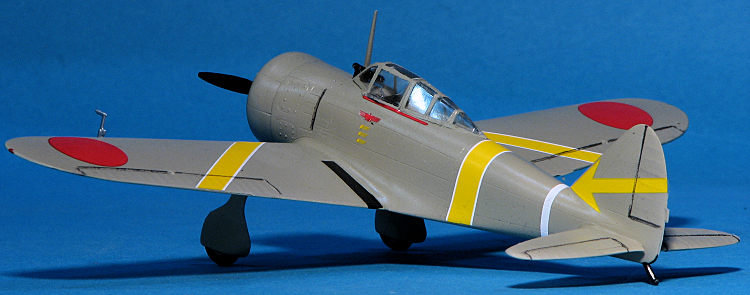 were built up and I filled the holes for
the under wing fuel tanks and the gun camera on the upper wing. Next, the
interior and instrument panel were installed and the fuselage halves closed. The
instrument panel fits into a slot in the upper fuselage interior and sits so far
back as to be practically invisible. There are no alignment lugs on the fuselage
or wings so care does have to be taken. Naturally, I had a bit of slip on the
fuselage and apparently on the wings as well as I had to do some filling and
sanding.
were built up and I filled the holes for
the under wing fuel tanks and the gun camera on the upper wing. Next, the
interior and instrument panel were installed and the fuselage halves closed. The
instrument panel fits into a slot in the upper fuselage interior and sits so far
back as to be practically invisible. There are no alignment lugs on the fuselage
or wings so care does have to be taken. Naturally, I had a bit of slip on the
fuselage and apparently on the wings as well as I had to do some filling and
sanding.
Once this was dealt with, the wings and fuselage were mated. I had to do considerable scraping on the fuselage wing roots to get a good fit and the appropriate dihedral on the wings. When installing the horizontal stabilizers, I had to trim back the tabs as they are so long as to prevent both stabs from properly fitting. With that done, the standard landing gear were installed. The kit offers options, which I like, but the other two were not required for this build.
The engine was painted and installed on the front of the fuselage, followed by the cowling, which needed some heavy sanding due to a step between the front and rear sections. The engine does not fit square if one can judge by the oil cooler on the front. The cowling fits very well. I then stuffed the cockpit and engine with tissue in preparation for painting.
| COLORS & MARKINGS |
Most Ki-27s are a cinch to paint as they are overall green-grey. I used some of my Xtracolor paint for this and ran into an issue of it producing little bits when thinned with lacquer thinner. This kept clogging my air brush, but I had no readily available substitute so simply worked with what I had. Eventually it was painted. I then masked the clear bits as best I could and glued those in place. Fit isn't the greatest. A hole for the radio mast was drilled and this part was installed. I did not clip it flush as I should have as the small sprue attachment point is a perfect way to mount it. A bit more painting and the airframe was clear coated with Future.
For markings, I chose a sheet I purchased just for this build
and recently previewed, LifeLike 72-035. I picked the markings for Tateo Kato
right after he took command of the 64th Sentai. I started with the fuselage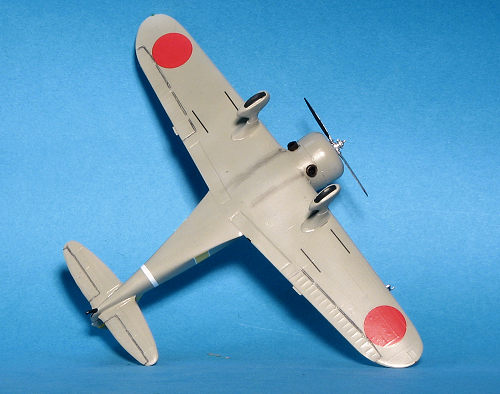 bands as they often make or break a set of markings. The broad yellow fuselage
band was too short to fit all the way around, but judging from the placement
guide, it is not supposed to fit on the underside at all, so I simply trimmed it
to fit. The small white band was a perfect fit. I used Microsol for all the
markings. Some black stripe decals were used for the wing walkway.
bands as they often make or break a set of markings. The broad yellow fuselage
band was too short to fit all the way around, but judging from the placement
guide, it is not supposed to fit on the underside at all, so I simply trimmed it
to fit. The small white band was a perfect fit. I used Microsol for all the
markings. Some black stripe decals were used for the wing walkway.
Once all that was in place, a coat of semi-matte was sprayed over everything. I then installed the pitot after removing the masking from the canopy. My lack of decent close vision showed that I did not do all that great a job of masking. I had to enlarge the opening in the windscreen to get the sight to fit. I had carefully cut away the exhaust and put them on a piece of tape for painting. THey were painting and somehow shortly disappeared. Undoubtedly stuck to the bottom of something, but I've yet to locate them so made some admittedly oversize ones out of Contrail tubing. These were glued on and painted followed by painting the tires and the attachment of the prop. A bit of pastel for the exhaust, control surfaces were highlighted with a 4B pencil, and some wing tip lights finished the project.
| CONCLUSIONS |
 Well, this
one went together with a bit more drama than I recall the one from a few decades
back, but is still less hassle than the RS kit was. Its age is very much showing
in terms of the raised panel lines and general lower level of detail, but then
it depends on just what you are seeking in a kit. Basically I seek an
interesting build for the shelves. If you want to go the contest route, you'd
probably do better with the RS offering, despite its more fiddly construction.
Hasegawa obviously isn't going to retool this one any time soon and it is still
very much available, especially from the second hand market. If one realizes
what they are starting with (early 70's tooling), then there should be no real
issues. It takes a bit of work, but the end is a fairly nice model. I know I
plan on doing a few more.
Well, this
one went together with a bit more drama than I recall the one from a few decades
back, but is still less hassle than the RS kit was. Its age is very much showing
in terms of the raised panel lines and general lower level of detail, but then
it depends on just what you are seeking in a kit. Basically I seek an
interesting build for the shelves. If you want to go the contest route, you'd
probably do better with the RS offering, despite its more fiddly construction.
Hasegawa obviously isn't going to retool this one any time soon and it is still
very much available, especially from the second hand market. If one realizes
what they are starting with (early 70's tooling), then there should be no real
issues. It takes a bit of work, but the end is a fairly nice model. I know I
plan on doing a few more.
June 2017
Copyright ModelingMadness.com. All rights reserved.
If you would like your product reviewed fairly and fairly quickly, please contact the editor or see other details in the
Note to
Contributors. Back to the Main Page
Back to the Review
Index Page
Back to the Previews Index Page